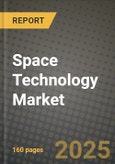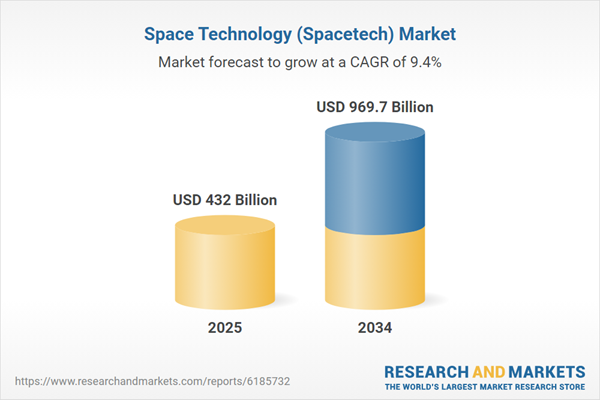The space technology (SpaceTech) market encompasses a wide range of technologies and innovations that enable space exploration, satellite communication, space-based navigation, Earth observation, and deep space missions. The rapid expansion of commercial space ventures, along with increased investments from both government agencies and private companies, has fueled the growth of SpaceTech. Key elements of this market include launch vehicles, satellite systems, propulsion technologies, and advanced space equipment. With major technological advancements in propulsion, miniaturization, and automation, SpaceTech is paving the way for more cost-effective, reliable, and frequent space missions. The commercial space industry has become a significant player, with companies like SpaceX, Blue Origin, and Virgin Galactic leading efforts in satellite launches, space tourism, and interplanetary exploration. As space technology continues to evolve, applications such as global connectivity, resource extraction from asteroids, and the potential for permanent human presence on the Moon and Mars are becoming more feasible. The increasing demand for sustainable space operations and the expansion of satellite constellations will continue to drive the development of new technologies and solutions in the SpaceTech market.
The SpaceTech market saw significant advancements, particularly in the fields of satellite technology and space launch systems. The increasing number of private space missions contributed to a higher frequency of satellite launches, and smaller, more affordable launch vehicles became a popular choice for small satellite operators. SpaceX’s successful launches with the Falcon 9 rocket, combined with ongoing innovations in reusable rockets, marked a year of progress in reducing launch costs and expanding access to space. The year also saw major developments in satellite communication systems, with the deployment of large satellite constellations designed to provide global broadband connectivity. Companies such as Starlink, OneWeb, and Amazon’s Project Kuiper continued to make headway in creating a network of satellites that would revolutionize internet access across the globe, particularly in remote and underserved areas. Additionally, advancements in propulsion technologies, including ion thrusters and green propulsion systems, gained attention as part of efforts to increase mission efficiency and reduce the environmental impact of space operations. 2024 was also notable for the growth of space exploration programs, with NASA’s Artemis mission continuing to move toward establishing a sustainable human presence on the Moon and preparing for Mars exploration.
The SpaceTech market is poised for significant growth driven by ongoing advancements in space exploration, satellite technologies, and private sector involvement. As space tourism and lunar exploration become more feasible, new technologies will emerge to support human missions beyond Earth’s orbit, including autonomous robotic systems and advanced life support systems for extended space travel. SpaceTech is also expected to play a pivotal role in resource extraction from asteroids and the Moon, as companies explore new avenues for utilizing space-based materials. The increasing reliance on satellite constellations for global communication and data gathering will drive demand for next-generation satellite technologies, including more efficient propulsion systems, smaller form factors, and enhanced onboard processing capabilities. As more nations and companies engage in space activities, the need for sustainable space operations and debris mitigation technologies will grow, leading to the development of systems designed to track and remove space debris. Furthermore, advancements in AI, machine learning, and quantum computing are likely to accelerate the development of autonomous space missions, enabling faster decision-making and more efficient operations in space. The SpaceTech market is set to continue its upward trajectory, with technological innovations transforming the future of space exploration, satellite communications, and space-based applications.
Key Insights: Space Technology (Spacetech) Market
- The development of smaller, more affordable launch vehicles for small satellite operators, leading to increased accessibility to space and a surge in satellite deployments.
- Growing investment in satellite constellations for global internet connectivity, offering high-speed broadband services to remote areas.
- Advancements in green propulsion systems and ion thrusters, designed to improve the efficiency and sustainability of space missions.
- The expansion of space tourism, with commercial spaceflights becoming more frequent and accessible to private individuals and researchers.
- Increased focus on space sustainability, with new technologies being developed to mitigate space debris and track space objects in real time.
- Commercialization of space with the rise of private space companies driving innovation in satellite launches, space tourism, and deep-space exploration.
- Technological advancements in propulsion, satellite miniaturization, and reusable launch systems that reduce costs and increase the frequency of space missions.
- Expansion of satellite constellations and global connectivity, with the aim of providing internet access to underserved areas and improving communication networks.
- Growing interest in space exploration, including missions to the Moon, Mars, and asteroids, leading to increased investment in space-based technologies and infrastructure.
- The high capital expenditure required for developing new space technologies, combined with the complexity of space operations, presents a significant barrier to entry and widespread adoption, particularly for new startups and emerging markets.
Space Technology (Spacetech) Market Segmentation
By Type
- Space Vehicles
- Spacecraft
- Space Stations
- Orbital Launch Vehicles
- Deep-Space Communications
- In-Space Propulsion
- Other Types
By Application
- Navigation and Mapping
- Meteorology
- Disaster Management
- Satellite Communication
- Satellite Television
- Remote Sensing
- Science and Engineering
- Military and National Security
- Internet Services
- Other Applications
By End-Use
- Government
- Military
- Commercial
Key Companies Analysed
- The Boeing Company
- Lockheed Martin Corporation
- Airbus SE
- China Aerospace Science and Technology Corporation
- General Dynamics Corporation
- Northrop Grumman Corporation
- Honeywell International Inc.
- NEC Corporation
- Safran S.A.
- Thales Group
- Ball Corporation
- Leonardo SpA
- SpaceX
- Hindustan Aeronautics Limited
- Viasat Inc.
- SES S.A.
- Maxar Technologies
- Eutelsat Communications SA
- Sierra Nevada Corporation
- OHB System AB
- National Aeronautics and Space Administration (NASA)
- MDA Space
- Telesat
- Rocket Lab USA Inc.
- ICEYE Inc.
- Blue Origin LLC
- Beijing Commsat Technology Development Co. Ltd.
- Astra Space Inc.
- Virgin Galactic
- Hedron
Space Technology (Spacetech) Market Analytics
The report employs rigorous tools, including Porter’s Five Forces, value chain mapping, and scenario-based modeling, to assess supply-demand dynamics. Cross-sector influences from parent, derived, and substitute markets are evaluated to identify risks and opportunities. Trade and pricing analytics provide an up-to-date view of international flows, including leading exporters, importers, and regional price trends.Macroeconomic indicators, policy frameworks such as carbon pricing and energy security strategies, and evolving consumer behavior are considered in forecasting scenarios. Recent deal flows, partnerships, and technology innovations are incorporated to assess their impact on future market performance.
Space Technology (Spacetech) Market Competitive Intelligence
The competitive landscape is mapped through proprietary frameworks, profiling leading companies with details on business models, product portfolios, financial performance, and strategic initiatives. Key developments such as mergers & acquisitions, technology collaborations, investment inflows, and regional expansions are analyzed for their competitive impact. The report also identifies emerging players and innovative startups contributing to market disruption.Regional insights highlight the most promising investment destinations, regulatory landscapes, and evolving partnerships across energy and industrial corridors.
Countries Covered
- North America - Space Technology (Spacetech) market data and outlook to 2034
- United States
- Canada
- Mexico
- Europe - Space Technology (Spacetech) market data and outlook to 2034
- Germany
- United Kingdom
- France
- Italy
- Spain
- BeNeLux
- Russia
- Sweden
- Asia-Pacific - Space Technology (Spacetech) market data and outlook to 2034
- China
- Japan
- India
- South Korea
- Australia
- Indonesia
- Malaysia
- Vietnam
- Middle East and Africa - Space Technology (Spacetech) market data and outlook to 2034
- Saudi Arabia
- South Africa
- Iran
- UAE
- Egypt
- South and Central America - Space Technology (Spacetech) market data and outlook to 2034
- Brazil
- Argentina
- Chile
- Peru
Research Methodology
This study combines primary inputs from industry experts across the Space Technology (Spacetech) value chain with secondary data from associations, government publications, trade databases, and company disclosures. Proprietary modeling techniques, including data triangulation, statistical correlation, and scenario planning, are applied to deliver reliable market sizing and forecasting.Key Questions Addressed
- What is the current and forecast market size of the Space Technology (Spacetech) industry at global, regional, and country levels?
- Which types, applications, and technologies present the highest growth potential?
- How are supply chains adapting to geopolitical and economic shocks?
- What role do policy frameworks, trade flows, and sustainability targets play in shaping demand?
- Who are the leading players, and how are their strategies evolving in the face of global uncertainty?
- Which regional “hotspots” and customer segments will outpace the market, and what go-to-market and partnership models best support entry and expansion?
- Where are the most investable opportunities - across technology roadmaps, sustainability-linked innovation, and M&A - and what is the best segment to invest over the next 3-5 years?
Your Key Takeaways from the Space Technology (Spacetech) Market Report
- Global Space Technology (Spacetech) market size and growth projections (CAGR), 2024-2034
- Impact of Russia-Ukraine, Israel-Palestine, and Hamas conflicts on Space Technology (Spacetech) trade, costs, and supply chains
- Space Technology (Spacetech) market size, share, and outlook across 5 regions and 27 countries, 2023-2034
- Space Technology (Spacetech) market size, CAGR, and market share of key products, applications, and end-user verticals, 2023-2034
- Short- and long-term Space Technology (Spacetech) market trends, drivers, restraints, and opportunities
- Porter’s Five Forces analysis, technological developments, and Space Technology (Spacetech) supply chain analysis
- Space Technology (Spacetech) trade analysis, Space Technology (Spacetech) market price analysis, and Space Technology (Spacetech) supply/demand dynamics
- Profiles of 5 leading companies - overview, key strategies, financials, and products
- Latest Space Technology (Spacetech) market news and developments
Additional Support
With the purchase of this report, you will receive:- An updated PDF report and an MS Excel data workbook containing all market tables and figures for easy analysis.
- 7-day post-sale analyst support for clarifications and in-scope supplementary data, ensuring the deliverable aligns precisely with your requirements.
- Complimentary report update to incorporate the latest available data and the impact of recent market developments.
This product will be delivered within 1-3 business days.
Table of Contents
Companies Mentioned
- The Boeing Company
- Lockheed Martin Corporation
- Airbus SE
- China Aerospace Science and Technology Corporation
- General Dynamics Corporation
- Northrop Grumman Corporation
- Honeywell International Inc.
- NEC Corporation
- Safran S.A.
- Thales Group
- Ball Corporation
- Leonardo SpA
- SpaceX
- Hindustan Aeronautics Limited
- Viasat Inc.
- SES S.A.
- Maxar Technologies
- Eutelsat Communications SA
- Sierra Nevada Corporation
- OHB System AB
- National Aeronautics and Space Administration (NASA)
- MDA Space
- Telesat
- Rocket Lab USA Inc.
- ICEYE Inc.
- Blue Origin LLC
- Beijing Commsat Technology Development Co. Ltd.
- Astra Space Inc.
- Virgin Galactic
- Hedron
Table Information
| Report Attribute | Details |
|---|---|
| No. of Pages | 160 |
| Published | October 2025 |
| Forecast Period | 2025 - 2034 |
| Estimated Market Value ( USD | $ 432 Billion |
| Forecasted Market Value ( USD | $ 969.7 Billion |
| Compound Annual Growth Rate | 9.4% |
| Regions Covered | Global |
| No. of Companies Mentioned | 30 |









